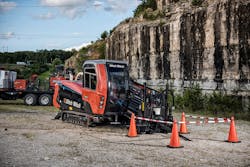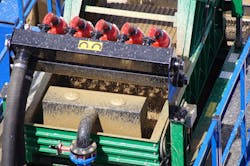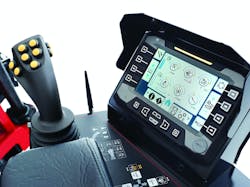Technology Advances the HDD Process
If the state of today’s HDD (horizontal directional drilling) industry had to be summed up in a few sentences, these might work: Business is good. Machine technology is advancing. The HDD contractor’s big challenges are the shortage of trained operators and the disposal of drilling fluid.
The HDD industry has endured its share of boom and bust times since the process was developed in the late 1980s, but, fortunately, good ideas also endure. In the past decade or so, the HDD industry has solidly established the value of the technique, and manufacturers, both of HDD rigs and the products that support the HDD process, continue to innovate.
“From the smallest to the largest rigs, the HDD market is doing well,” says Richard Levings, director of product management, American Augers. “We continue to see methods change from open-cut to trenchless, and the predominant trenchless technique is HDD—especially for new installations. The use of HDD for rehabilitation is growing in a major way, however, and will become a dominant market for HDD.”
Tod Michael, Vermeer’s product manager, trenchless core products, provides details.
“Overall, the North American horizontal-directional-drilling market is strong. Fiber-optic work, as well as gas and distribution services, are significant drivers right now in the United States and Canada. Also, as infrastructure construction continues to trend upward, many cities are upgrading their utilities—with new electrical lines, water-line replacements, and sewer-rehabilitation leading the way. And in Texas, Colorado, Pennsylvania, and the Dakotas—we’re seeing increases in pipeline work.”
Seth Matthesen, Ditch Witch HDD category manager, sees market stability and increased telecommunications work as factors benefitting HDD contractors at present.
“The HDD market is stable. We’re seeing growth in the telecommunications segment of the market as projects increase for expanded bandwidth and the building of new 5G networks.”
The upward trend in the HDD market over the past few years, says Kevin Conry, Toro senior marketing manager, can be attributed in part to what seems to be a continuing discovery of the value of HDD among energy- and utility-installation contractors.
“From natural-gas pipelines, to wind and solar conduit, to telecommunications installations, utility contractors in North America have realized the inherent benefits of directional drills, compared with [open-cut] excavating or trenching,” says Conry. “The HDD industry, in general, is doing very well, and as increased connectivity continues to be a priority for consumers, directional drilling will continue to be a preferred method of installation.”
Product innovation
Herrenknecht describes it new HK180CK, having 180,000 pounds of thrust/pullback force, as “compact”—a descriptor one might expect applied to a rig that fits through a backyard gate. Compared with the next-largest model in the line, however, which requires a relatively large job-site footprint to accommodate its off-board pump and operator’s cabin, the new HK80CK is, relatively speaking, quite compact, having these components on-board. The new model also uses shorter pipe than its larger counterpart, further reducing its on-site footprint.
Herrenknecht also has introduced a hybrid version of the HK80CK, which is completely electrically powered via a 250 kW “E-Motor” when at work. A small diesel propels the machine when maneuvering on site, but the engine is shut down during drilling.
Newest in the American Augers’ line is the DD-240T, having 240,000 pounds of thrust/pullback force and 43,900 lb.-ft. of rotational torque. The DD-240T uses 523-horsepower MTU engine and a mud pump capable of flows to 300 gpm at pressures to 1,109 psi.
“The DD-240T is a new concept for American Augers,” says the company’s Levings, “in that it’s more self-contained than our larger drills, and its flexible design allows contractors to configure the unit to meet particular needs. The operator’s cabin can be removed, for example, if the operator prefers to run the machine from the ground to reduce noise and vibration present on some projects. The base model also can be configured to to handle either Range 1 [18- to 22-foot] or Range 2 [27- to 30-foot] pipe, depending on site conditions, and it’s available with or without a pipe loader and with or without an on-board pump.”
According to Toro, its new DD2226, with 22,000 pounds of thrust/pullback force and 2,600 lb.-ft. of rotational torque, has the power to turn larger reamers in tough ground conditions. The DD2226 has the capacity for 400 feet of 10-foot pipe, and its “quad-pinion” carriage design features a “dual-sided” rack for spreading loads evenly to promote stable carriage movement. The unit is equipped with Toro’s SmartTouch system, which is designed to speed pipe-loading cycle time, and the operator can switch between single- or dual-joystick control any time during the bore.
“The most important advancements we’re seeing in machine design are those for controls,” says Toro’s Conry, “because utility contractors are challenged today in finding skilled operators. To minimize the learning curve for new operators and to allow experienced operators to work more efficiently, the SmartTouch feature allows advancing through the pipe-handling process with a touch of a rocker switch on the joystick.”
The 12-model Ditch Witch range now includes the AT40 All-Terrain. According to the company’s Matthesen, the new drill features an “advanced, two-pipe, all-terrain drilling system” that provides ample torque to work in challenging underground conditions, such as hard rock.
“What differentiates the AT system from conventional mud motors,” says Matthesen, “is its use of the drill’s power to efficiently drive the bit. At the core of the AT system is dual-pipe technology, which has an inner drive shaft that reaches back to the drill and allows controlling exactly how much horsepower is sent down-hole.”
Vermeer has an extensive 17-model HDD line, which includes two recent models, the compact D8x12 Navigator, designed primarily for service installations (gas, water, power, and communications) and the D40x55DR S3 Navigator, which, says Vermeer, can work in a broad range of ground conditions, including hard rock. According to the company’s Michael, the D40x55DR S3 features “dual-rod technology,” which employs an inner rod to provide torque to the drill bit and an outer rod that provides steering capability and rotational torque for reaming.
“This combination [inner and outer rods] provides powerful, down-hole cutting action,” says Michael, “as well as the flexibility to select the appropriate tooling to best match the ground conditions, allowing the entire installation to be completed with one machine.”
American Augers’ Levings also notes that technical advancement in locating systems—that is, methods for tracking and guiding the bore head—also is contributing to the overall efficiency of the HDD process.
Basically, three methods are available: walkover, in which information from a transmitter (sonde) behind the bore head is sent electromagnetically to a surface receiver; wire-line, in which information from the bore head is collected electronically and transmitted to the surface via a wire inside the drill string; and, most recently, “gyro-based” systems, described in a paper by Oliver J. Woodman, “An Introduction to Inertial Navigation,” as systems that use measurements from accelerometers and gyroscopes to track the position and orientation of an object relative to a known starting point, orientation, and velocity.
“Today, the HDD contractor has a ‘toolbox’ of locating technologies from which to choose,” says Levings, “depending on which best suits the operating conditions of a particular job.”
HDD challenges
“Four or five years ago, most HDD contractors were saying that fluid disposal was their first concern, with the shortage of labor a close second,” says Levings. “Today, that order is reversed; getting good labor is a real problem for many contractors.”
On the labor front, says Toro’s Conry, the company and its dealers are increasingly focusing efforts to provide tools, training, and support for HDD contractors to assist in building up the workforce. In addition, he says, machine designs that incorporate sophisticated, yet easy-to-use software, such as the company’s SmartTouch technology, can assist operators in becoming proficient in a shorter time.
“As the underground construction market continues to grow,” says Ditch Witch’s Matthesen, “connecting with the next-generation workforce and retaining experienced operators through effective training is a priority for the industry. In response, the Ditch Witch organization offers a series of HDD training courses online and in-person at dealerships. New and experienced operators also can use the Ditch Witch ‘reality simulator’ to prepare for unique job-site challenges in a safe environment before stepping onto the job site.”
In fall 2015, says Michael, the company launched its “HDD Circuit” training program, an intensive two-week course, he says, that pairs eight students with four full-time Vermeer instructors to learn all aspects of the HDD process—drill operation, locating, bore planning, drilling-fluid mixing, vacuum excavating, machine maintenance, and job-site safety. Vermeer also recently introduced its Navigator HDD Simulator 1.0, which, says Michael, delivers the realistic experience of sitting behind the controls of a Vermeer unit.
The concern about fluid disposal, says American Augers’ Levings, is being addressed by the industry with evolving technology that allows efficient recycling of drilling fluid, thus reducing the volume of fluid requiring disposal, as well as new technology for mechanically and chemically processing the tailings of the recycling process and the fluid remaining at the end of the project.
According to Vermeer’s Michael, regulations targeting the disposal of HDD fluids and the rising costs of disposal are significantly affecting the contractor’s productivity and efficiency.
“Reclaiming and solidifying HDD fluids are two areas Vermeer is focusing on to help contractors control their costs and stay productive,” he says. “Both require additional equipment that might not make sense for every project, but reclaiming drilling fluid can be a viable solution for larger HDD projects, such as installing pipelines, and solidification can work well for large-scale utility projects around a more central location.”
If contractors are considering a recycling system, says American Auger’s Levings, they should be aware of how the capacity of these systems is rated. In layman’s terms, he says, most recycling systems use an initial “shaker” or screen to separate out large solids, followed by a series of centrifugal cones that separate out smaller particles. The conventional rating, he says, is based on the amount of water a centrifugal cone can pass in a given time, multiplied by the number of cones.
“A truer measure of capacity,” says Levings, “is the volume of back-reamed fluid that the primary-cut shaker can process. This method of measuring capacity is based on the material the contractor is actually producing, not on water. If the primary shaker can handle only 600 gallons per minute, for example, and the contractors needs 1,000, then the drilling process will always be waiting on the cleaning system. You might be able to compensate by opening up the screen, but then you’ll overwork the cones and wear things out more quickly.”
The residue resulting from the recycling process often contains enough moisture that moving it creates problems, says Levings, as does the disposal of perhaps thousands of gallons of “mud” (drilling fluid full of cuttings from the bore) that remain at the end of a project.
“The industry now has the options of using a centrifuge to get the mud down to relatively clear water that can be transported out for disposal,” he says, “or using a solidification process to create a dry product that can be handled more easily than the fluid. The drying—or solidification—process involves using a small amount of a chemical agent, which can be mixed into the HDD fluid with, say, an excavator, or more often, with a separate piece of mixing equipment on site.
“As with tracking systems, the HDD contractor now has a toolbox of alternatives for managing drilling fluid.”


